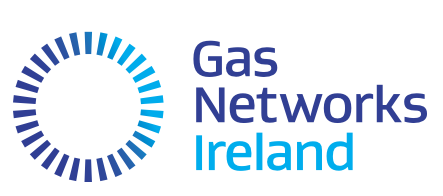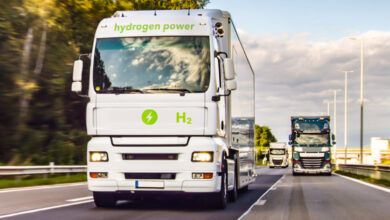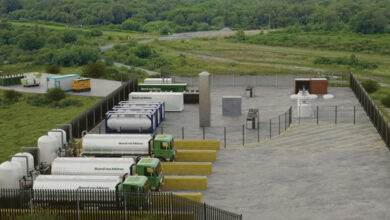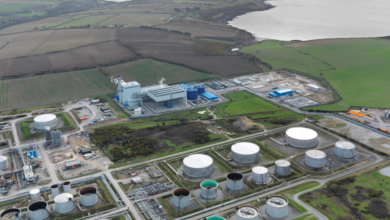Preparing Ireland’s gas network to transport hydrogen
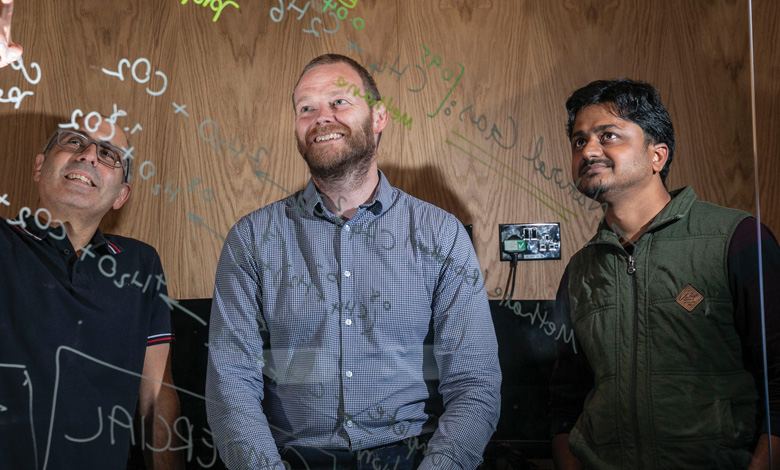
A decarbonised gas network will help reduce emissions, support the achievement of Ireland’s climate ambitions and secure Ireland’s energy security with least disruption.
The gas network infrastructure can be adapted to transport zero carbon gases, such as green hydrogen. It has already transformed once, from carrying town gas to natural gas over 40 years ago, and more recently adapted to biomethane when it was first introduced onto the Irish network in 2019.
To ensure that the Irish gas network is ready to transport hydrogen, Gas Networks Ireland is working with research institutes and academia, including its research project with University College Dublin Energy Institute (UCDEI).
Gas Networks Ireland is preparing the network to safely transport blends of hydrogen in the natural gas imported from the UK through its two subsea interconnectors. Ireland currently imports 77 per cent of its natural gas demand, and the entire transmission and distribution system is being assessed to be hydrogen ready.
Phase One of this research found that domestic appliances such as gas boilers could take up to 20 per cent of hydrogen blended with natural gas without the need for retrofitting.
Phase Two of the research which concluded in late 2023, involved over 300 of the largest users of networked gas in the country and found that 90 per cent of the end users’ equipment is compatible with blends of 20 per cent hydrogen, while the remaining 10 per cent of Irish industry would need further assessment to determine the extent of modifications required.
Phase Three of this research, HyGreenNet will focus on the gas network and investigate the operational, safety and material compatibility, and is underway with initial results expected by the end of 2024.
Gas Networks Ireland is also working with AMBER, the Science Foundation Ireland’s centre for Advanced Materials and Bioengineering Research to undertake important research to determine how compatible the materials that make up Ireland’s gas pipeline are with hydrogen – an important first step for green hydrogen in the decarbonisation journey of Ireland’s gas network. The research project “Material Testing and Development under Variable Hydrogen Ratios” is being carried out by scientists from AMBER – SFIs multi–University Centre for world class Advanced Materials and Bioengineering Research, hosted at Trinity College Dublin – in conjunction with engineers from Gas Networks Ireland.
Another research collaboration underway is with the Hydrogen Safety Engineering and Research Centre (HySAFER) at Ulster University looking at the safety of hydrogen blends in the gas network with peer gas network operators in Northern Ireland.
Additionally, Gas Networks Ireland is one of several industry stakeholders funding a €16 million strategic partnership with Irish third-level institutions that will examine how to holistically decarbonise the overall Irish energy sector. Hosted by UCDEI, NexSys (Next Generation Energy System) is also supported by Science Foundation Ireland (SFI).
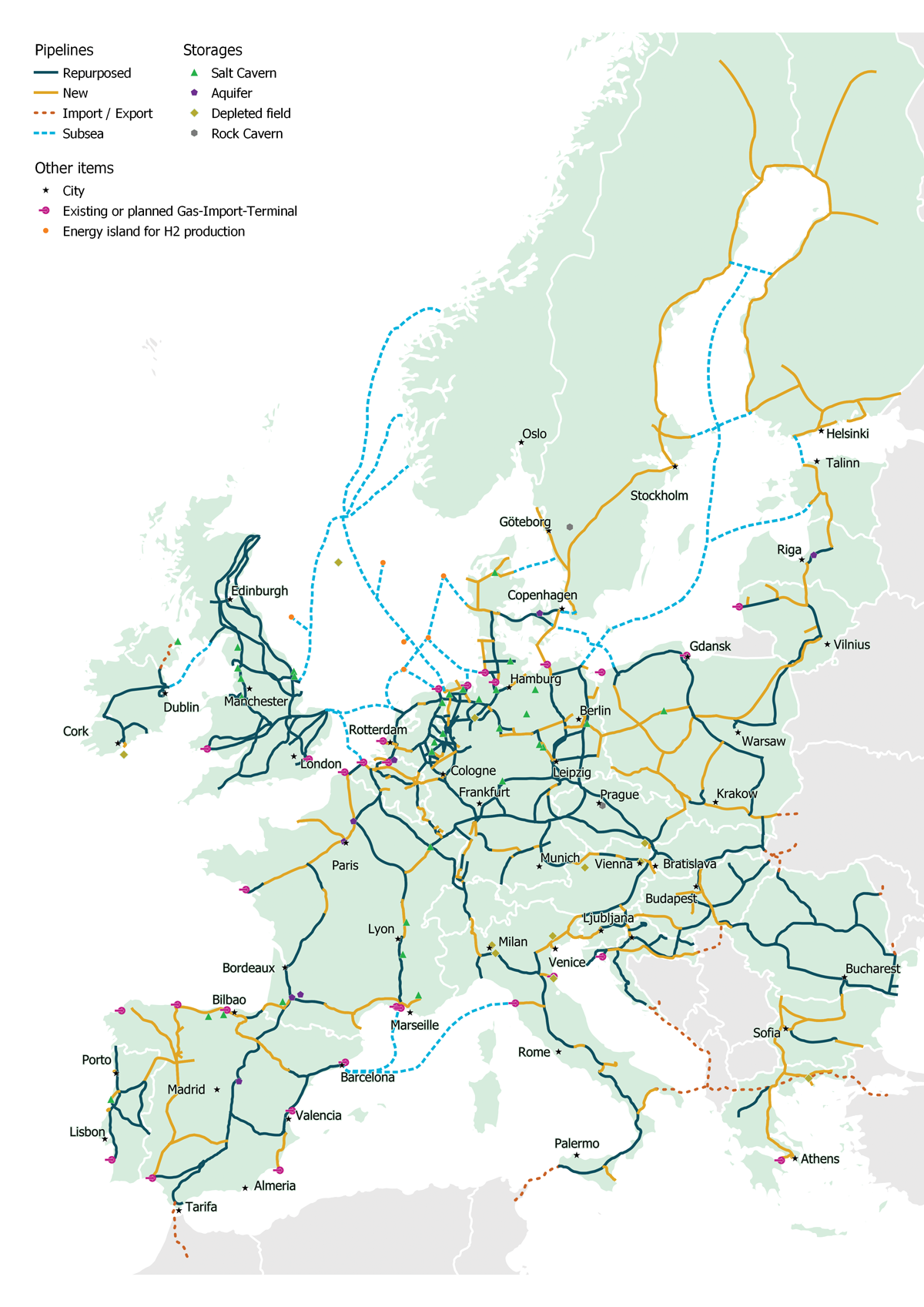
|
Gas Networks Ireland’s Hydrogen Programme Director
To progress its hydrogen ambition, Gas Networks Ireland has formed a dedicated hydrogen team led by a Hydrogen Programme Director. Brian Mullins has been appointed to this newly created role. Brian has 20 years’ experience across a number of senior roles in both the supply and networks aspects of the gas business. Brian joined Bord Gáis Éireann on its Graduate Programme in 2004, working firstly in the gas and electricity trading side of the business before joining the Networks business in 2013. Brian holds degrees in Commerce (B.Comm) and Economics (MEconSc) from University College Cork and a Diploma in Management Practice from the IMI. |
Timeline: Ireland’s gas network hydrogen evolution
2024-2030: Preparing for hydrogen blends
• Getting the existing gas network ready to accept blends of hydrogen/natural gas at the Moffat Interconnection Point in Scotland and accept green hydrogen injection at certain points on the gas network.
2024-2030: Cluster development
• Support the development of hydrogen clusters through repurposing gas infrastructure, including the production, storage, transport and end-use of green hydrogen at key locations.
2030-2040: Gas network conversion
• Hydrogen networks are developed to link these clusters by repurposing existing pipelines, providing access to decarbonisation for gas dependant customers not in proximity to the clusters.
2040-2045: European Backbone:
• Repurposing one of the existing gas interconnectors to enable green hydrogen export/import, providing energy system resilience and access to the UK and European hydrogen networks.
European Hydrogen Backbone
Gas Networks Ireland is participating in a major project to help the European Union meet its new accelerated goals and radically increase the use of hydrogen by 2030. The European Hydrogen Backbone initiative is focussed on planning for the future development of a hydrogen market. Five large-scale hydrogen pipeline corridors are envisaged. These new corridors will initially connect domestic local hydrogen supply and demand in Europe, before expanding and connecting European regions amongst each other, and then connecting neighbouring regions with hydrogen export potential. The planned Hydrogen Backbone network will largely be based on repurposing existing natural gas infrastructure. It is anticipated that by 2040, Ireland could be connected to the new European Hydrogen Backbone via a repurposed subsea pipeline to the Moffat Interconnector in Scotland.
Celtic Hydrogen Cluster
Hydrogen clusters or hydrogen valleys are where hydrogen production, transport storage and end use occur within a local geographical region. These clusters often will centre around large industrial energy users who are leveraging hydrogen in order to decarbonise their processes and/or heat demand. In the National Hydrogen Strategy, clusters have been identified as likely to form in the early stage of the hydrogen market evolution between 2025 and 2035, as locating hydrogen production, storage and end use in close proximity reduces the need for larger capital expenditure to transport the hydrogen. In time, these clusters will be linked by dedicated hydrogen networks to improve their security of hydrogen supply and provide them access to international hydrogen markets for import and export.
In Ireland, a number of clusters are anticipated to develop in regions such as Cork, Dublin, Galway, and Limerick. Progress has already been made in Cork where the Celtic Hydrogen Cluster was launched in November 2023. The Celtic Hydrogen Cluster is looking to benefit from the existing nexus of energy producers and consumers which are currently connected by or in close proximity to an existing natural gas network which could be repurposed to transport and store hydrogen to stimulate a hydrogen cluster in this area to take advantage of the offshore wind energy which will be produced from the Celtic Sea in the future. The companies currently involved, include the owners and operators of large power stations, the oil refinery, renewable energy developers and Gas Networks Ireland. Gas Networks Ireland has joined together in order to progress individual and joint projects which all fall under the umbrella of the Celtic Hydrogen Cluster.
|
Renewable gas of the future – green hydrogen Green hydrogen is a carbon free gas that can be made from renewable electricity through a process known as electrolysis. Ireland has a significant opportunity to develop indigenously produced renewable/green hydrogen at scale and decarbonise sectors which are hard to decarbonise and fully optimise its renewable generation potential. Embedded in this is an opportunity to utilise the existing gas network to transport and store hydrogen and deliver greater integration between Ireland’s gas and electricity networks. The EU is predicting that approximately 14 per cent of energy consumption across Europe will be from hydrogen by 2050, and up to 20-35 per cent of the total energy demand in the UK. In Ireland’s case, at least 2GW of non-grid limited capacity is targeted to be in development by 2030. As noted in the National Hydrogen Strategy, the development of hydrogen at scale in Ireland will require the development of a national hydrogen network and the repurposing of existing gas network assets can offer cost savings versus the alternative of building a new hydrogen network from scratch. To prepare Ireland’s 14,725km gas pipeline to transport hydrogen, Gas Networks Ireland is:
|
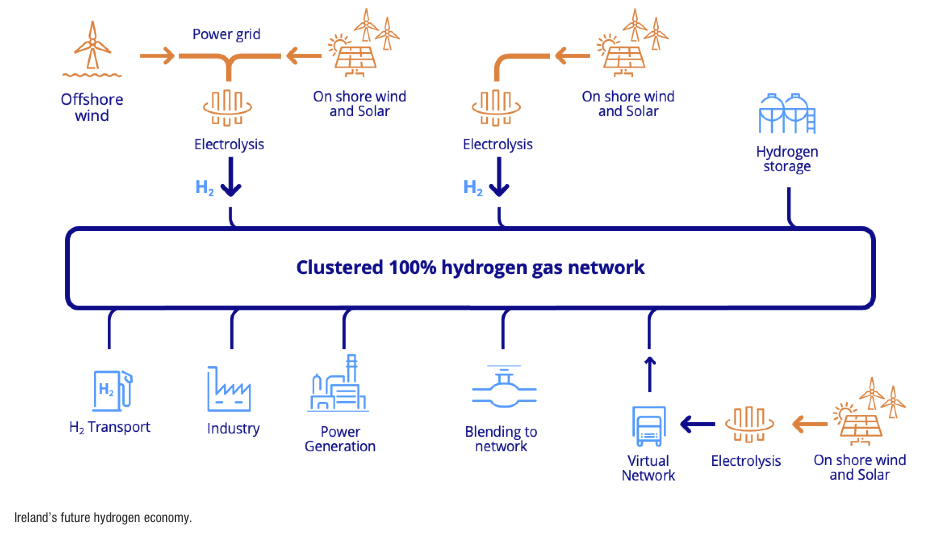
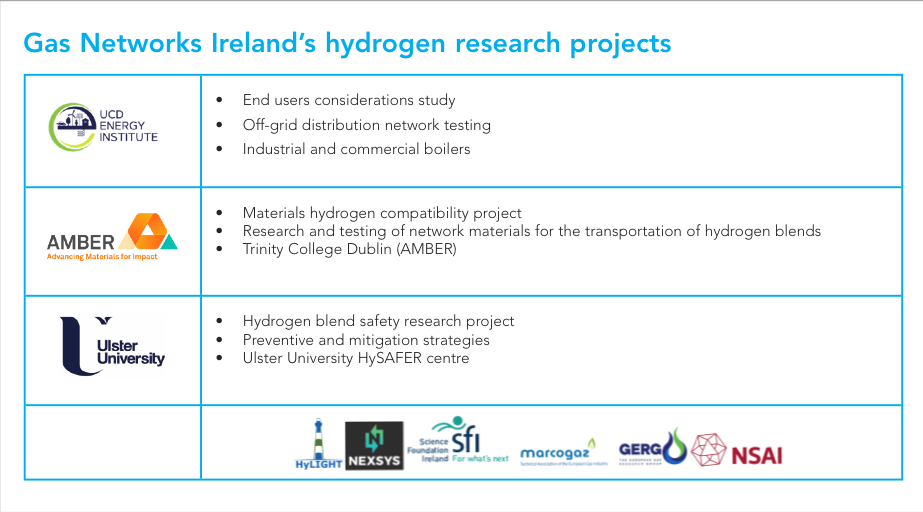
|
Government’s National hydrogen Strategy Gas Networks Ireland strongly welcomed the publication of the Government’s National Hydrogen Strategy in July 2023 as an important milestone in the decarbonisation of Ireland’s gas network, which is essential in the transition to a net-zero energy system in Ireland by 2050. The report published by the Department of Environment, Climate and Communications (DECC) outlines the future role green hydrogen gas – harnessed from offshore wind – and the gas network will play in specific areas of Ireland’s energy system and the hard to abate sectors such as transport, industrial heating and power generation. The gas network is Ireland’s hydrogen-compatible infrastructure and reliable energy backbone which will continue to play a central role in the country’s future clean energy and hydrogen economies. The cost of repurposing the existing gas network to transport hydrogen is estimated to be a fraction (10 per cent to 35 per cent) of the cost of building new dedicated hydrogen pipelines, and as the gas pipelines are already in the ground, it is the least disruptive option to help create a national hydrogen network at scale. |
W: www.gasnetworks.ie/hydrogen

